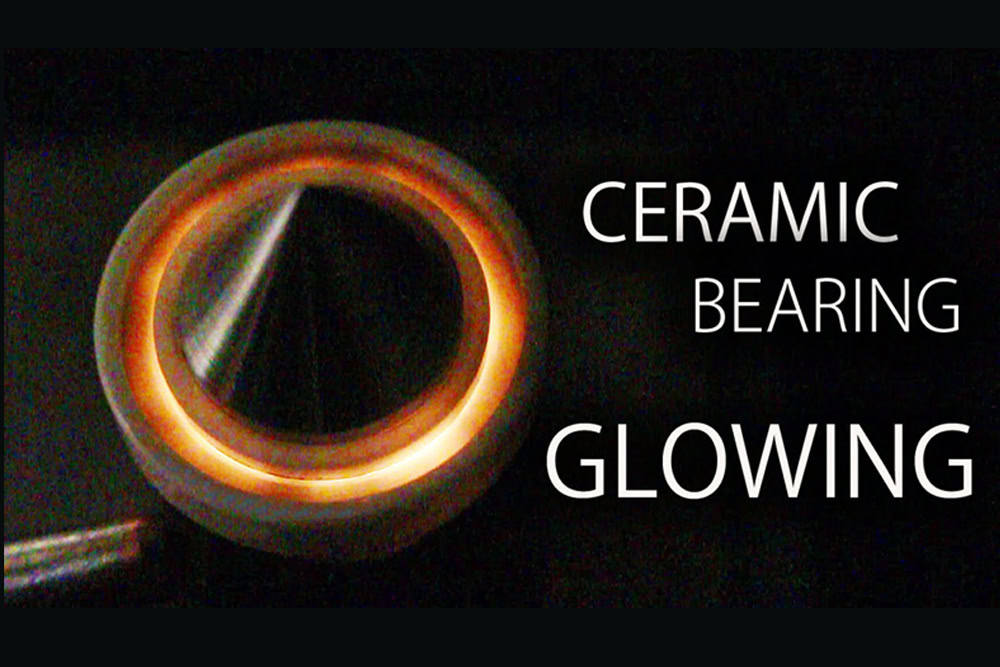
Bearing Manufacturer & Supplier
Specialize in ball bearings, roller bearings, thrust bearings, thin section bearings etc.
Why Do Ceramic Bearings Glow at High Speeds?
As a high-performance bearing material, ceramic bearings perform well in high-speed, high-temperature and high-load working environments due to their excellent wear resistance, corrosion resistance, electrical insulation and high-temperature stability. However, when ceramic bearings rotate at high speeds, luminescence often occurs, which has attracted widespread attention. This article will analyze the luminescence phenomenon of ceramic bearings rotating at high speeds, and explore its causes, influencing factors and potential application value.
Table of Contents
ToggleCauses of the luminescence phenomenon
When ceramic bearings rotate at high speeds, sparks will continue to be generated due to the collision between the ceramic balls and the inner and outer rings. This visual effect is like the bearings “glowing”. This luminescence phenomenon is mainly due to the friction and collision between the ceramic balls and the inner and outer rings of the bearings during high-speed rotation, resulting in energy conversion into light and heat.
This is a common physical phenomenon that indicates that the bearing is experiencing high-speed rotation and friction. Not only does it occur in ceramic bearings, but other types of bearings may also experience similar phenomena when rotating at high speeds.
Influencing factors
Rotation speed: The luminous intensity of ceramic bearings is closely related to the rotation speed. As the rotation speed increases, the frequency and intensity of friction and collision will also increase, resulting in an increase in luminous intensity.
Material properties: The material properties of ceramic bearings also have a certain influence on the luminous phenomenon. The wear resistance, hardness and thermal conductivity of different materials will affect the degree of friction and collision, thereby affecting the luminous intensity.
Lubrication conditions: Lubrication conditions also have an important influence on the luminous phenomenon of ceramic bearings. Proper lubrication can reduce the friction coefficient, reduce the degree of friction and collision, and thus reduce the luminous intensity. However, excessive lubrication may also cause splashing and burning of lubricating oil, increasing the luminous intensity.
Working environment: Factors such as temperature, humidity and pollutants in the working environment will also affect the luminous phenomenon of ceramic bearings. High temperature and humid environment may cause the performance of bearing materials to decline and increase the degree of friction and collision; while pollutants may enter the bearing, causing friction to increase and increase the luminous intensity.
Potential application value
Monitoring of working status: The luminous phenomenon can be used as an intuitive indication of the working status of ceramic bearings. By observing the intensity and frequency of the luminescence, the working state of the bearing can be preliminarily judged, such as whether there are problems such as wear and poor lubrication. This provides the possibility for real-time monitoring and maintenance of the equipment, helps to timely discover and deal with potential problems, and prevent equipment failures.
Reference for performance optimization: The luminescence phenomenon can also be used as a reference indicator for the performance optimization of ceramic bearings. By studying the relationship between the luminescence phenomenon and factors such as bearing materials, lubrication conditions, and working environment, the design and manufacturing process of the bearing can be optimized to improve the performance and reliability of the bearing. For example, by improving the lubrication method or reducing the intrusion of pollutants, the luminescence intensity can be reduced, thereby increasing the service life and stability of the bearing.
Development of new materials and designs: The study of the luminescence phenomenon of high-speed rotation of ceramic bearings can also provide guidance for the development of new materials and designs. For example, by researching and developing ceramic materials with lower friction coefficients, higher wear resistance, and better thermal conductivity, the luminescence intensity can be further reduced, and the working efficiency and life of the bearing can be improved.
Fault diagnosis and prediction: Changes in the luminescence phenomenon may be related to certain failure modes of the bearing. By monitoring and analyzing the changing trends of the luminescence phenomenon, possible failures of the bearing can be predicted, and intervention and repair can be carried out in advance. This is of great significance for improving equipment reliability and reducing maintenance costs.
Conclusion
The luminescence phenomenon of ceramic bearings during high-speed rotation is a visual phenomenon caused by friction and collision inside the bearing during high-speed rotation. Its cause is closely related to factors such as speed, material properties, lubrication conditions and working environment. Although the luminescence phenomenon may indicate that there are some problems with the bearing, it also has certain application value and can be used as a reference indicator for bearing working status and performance optimization. In the future, with the continuous development and improvement of ceramic bearing technology, it is believed that the luminescence phenomenon will be studied and applied deeply.




